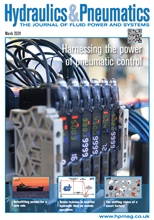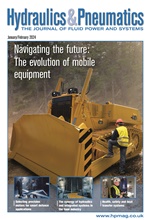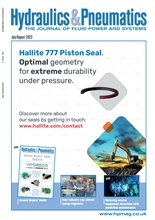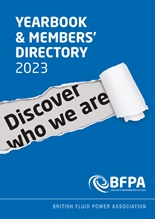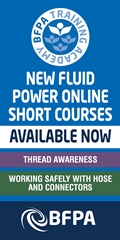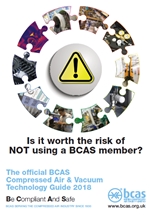- Home » Editorial » Hydraulics
Metal 3D printing by Aidro Hydraulics
Today, additive manufacturing (AM), or 3D printing, is commonly used in special fields such as dental, medical and luxury goods. It is also increasingly being deployed in industries as aerospace, automotive and oil & gas.
In the hydraulic sector, metal 3D printing has been introduced by Aidro Hydraulics, a family-run company founded in the northern Italian province of Varese by engineer Paolo Tirelli in 1982. Taking advantage of its technical knowhow in hydraulics, Aidro has begun to produce metal 3D printed hydraulic components as an alternative to the traditional production methods, in order to meet specific needs of customers.
The traditional manufacturing of hydraulic components starts with metal bar or with mould casting. The piece is then milled with a CNC machine to reach the desired shape. In the case of AM, manufacturing starts with loose material that is then built into a three-dimensional shape. Aidro has introduced AM based on metal powder bed fusion technology, which uses fine metallic powders as the feed material. The metal powder particles are melted using a high-power laser in sequential ultra-thin layers, creating functional hydraulic 3D products.
Alternative methodology
This technology offers many benefits such as a high degree of customisation, complex geometries, lighter forms and short lead time. Aidro is now exploiting these advantages in order to offer customers an alternative to traditional hydraulics manufacturing techniques.
Starting from the design or re-design of hydraulic components to be 3D printed, Aidro can produce a 3D-printed prototype. After testing it, the final hydraulic parts can be produced with AM for small series or with traditional methods for larger volumes. Aidro states its tests demonstrate that the 3D printed products are comparable to the traditional manufactured products in terms of pressure resistance, mechanical properties, porosity and density.
In the case of prototyping, Aidro comments that 3D printing allows projects to develop faster than ever, due to the short production time (a matter of days). Moreover, the cost of a 3D-printed prototype is considerably lower than prototyping casting moulds or traditional machining, which requires large volumes. Moreover, adds Aidro, with AM it is possible to print hydraulic prototypes of different shapes within a single production batch.
Realising the potential
With these advantages, Aidro believes many projects that have been closed in a drawer due to traditional prototyping limits will now have a better chance of being realised.
Besides his traditional product range, Aidro is now producing hydraulic components with AM. One example is a 3D-printed hydraulic valve block for single-action cylinder control. This 3D-printed hydraulic manifold demonstrates how a traditional solution can be virtually re-invented using a different design approach: simply install the necessary valves and connect them as desired. The internal channels of the valve block are optimised to enhance flow and save space, while the risk of leakages is claimed to be eliminated, as auxiliary drillings are no longer needed.
As well as the 3D-printed hydraulic manifolds, Aidro has designed, or re-designed, many other hydraulic products; such as the stackable directly operated pressure reducing valves. The body of this valve has been re-designed to be 3D printed in order to have a lightweight hydraulic valve. Indeed, AM allows a high reduction of the material used for the production.
In the first step, the valve body maintains the same external walls as the traditional product, but it is empty inside and the weight saving is said to be 40%. The second example is a redesigned valve body, in which the material has been removed where it was not necessary and the final weight is claimed to have been reduced by 60%.
Aidro has 3D-printed the valve body in stainless steel, and the pressure tests reportedly have demonstrated the same results as the traditional manufactured valves in steel zinc plated.
Another example of the possibilities offered by AM can be found in the hydraulic spools that Aidro has redesigned with new holes forms; such as oval holes and square holes. The company comments that these shapes are impractical with traditional manufacturing, particularly with CNC machining, while with AM complex geometries are now feasible.
With the new holes forms, Aidro has increased the passing area of oil inside the spool, facilitating a lower pressure drop. Therefore, the new design with AM offers a higher performance level.
Consolidation
Moreover, with the ability to build complex geometries, Aidro has consolidated more components into one piece and the 3D-printed spool is one single part. This allows the simplification of the manufacturing process and a reduction in assembly time.
By using AM in hydraulics, Aidro offers a variety of materials such as stainless steel with a high level of corrosion resistance, lightweight aluminium or maraging steel which is known for possessing superior strength and toughness without losing malleability. Also, other metals as titanium or inconel – not so commonly used in hydraulics – can be re-evaluated as 3D-printed materials for hydraulic parts.
Aidro’s CEO, Valeria Tirelli, and managing director, Alberto Tacconelli, conclude that they are strong believers in the future of 3D-printed products in hydraulics.
-
Smart Manufacturing & Engineering Week
05 - 06 June, 2024
NEC, Birmingham -
HILLHEAD 2024
25 June, 2024, 9:00 - 27 June, 2024, 16:00
Hillhead Quarry, Buxton, Derbyshire UK



